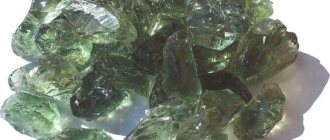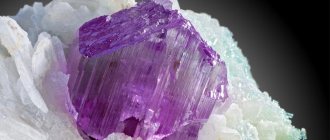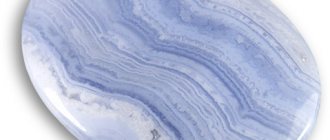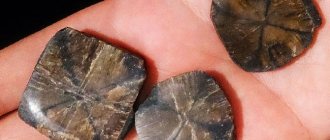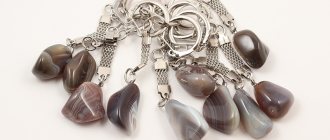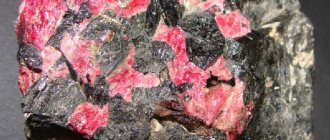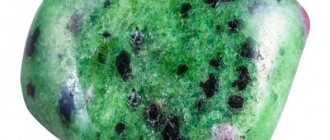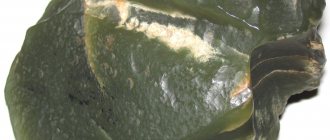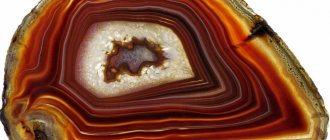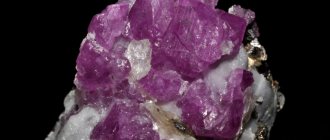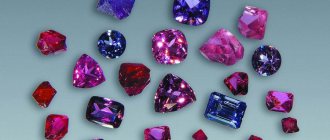Cubic zirconia is an artificial crystal grown from zirconium dioxide, which has no analogues in the world. Cubic zirconia is an artificial crystal grown from zirconium dioxide, which has no analogues in the world.
In the late 60s, cubic zirconia first appeared in a photo of a Soviet newspaper, and due to its similarity to diamonds, it gained high popularity in various industries: jewelry, chemical industry and optics.
There are several ways to distinguish cubic zirconia from a diamond:
- Cut shape. Cubic zirconia has rounded edges. The edges of a diamond are always sharp.
- Hardness. The stability of cubic zirconia is one third lower than that of a natural mineral, which means that scratches may appear on its surface.
- Shine. Without polishing, cubic zirconia will fade over time. A diamond shines even when neglected.
- Thermal conductivity. The cubic zirconia heats up in the palms, but the diamond always remains cold. Despite the difference, cubic zirconia can replace any jewelry, as it is available to everyone, regardless of financial situation.
History and origin
Cubic zirconia is a human creation and the triumph of technology in copying natural processes. The fate of the stone and its name is a plot for a detective story.
cubic zirconia
What is cubic zirconia
The crystals are obtained from zirconium dioxide. When processed, they almost copy a diamond in external and physical parameters, which is why in the Soviet Union artificial diamonds were called cubic zirconia.
There is a natural mineral of comparable qualities - tazheranite, found in the Tazheran Gorge near Lake Baikal. But its crystals are small, like jewelry, and are not used.
How it appeared
It was obtained artificially in the 1960s by physicists from the Lebedev Physical Institute of the Academy of Sciences. They called it by its first letters - FIANit.
Scientists experimented with a composition for the production of laser equipment, and the shiny material was considered defective production waste. Institute staff sorted the stones into souvenirs.
Enterprising citizens “helped.” Having brought the raw materials to marketable condition, they established sales to the West. At first they were delighted with the cheap “diamonds”. Then a scandal broke out and an investigation began. The traces led to the USSR.
The story was hushed up. The Europeans were uncomfortable with being fooled by the “backward Russians.” A limited circle of people in the Union knew about this, since the activities of FIAN were not advertised.
The party gave the task to scientists to create colored analogues of the stone for sale as jewelry. It was, of course, fulfilled; transparent multi-colored crystals at prices affordable for citizens filled jewelry stores. There was even a plan to release the stones.
Name confusion
The term “cubic zirconia” is used in the territory of the former USSR and Eastern Europe (former socialist countries). In the rest of the world, the material is known as zirconite, shelby, cubic zirconia, jevalite, and daimonsquay.
Sometimes cubic zirconia is called zircon or zirconium. But these are different things:
- cubic zirconia - synthetic, imitation diamond;
- zircon is an independent yellow-brown mineral;
- zirconium is a chemical element.
Misunderstandings arose because not everyone in the world wants to recognize the country's authorship. They also cannot forgive the embarrassment of half a century ago.
Confusion in terminology
The term “cubic zirconia” is used only in the CIS countries and Eastern Europe.
In the global jewelry community, other names are used to describe the insert in a product:
- jewellite;
- zirconite;
- daimonsquay.
Cubic zirconia is incorrectly called zirconium. Zirconium is a metal, and only its cubic dioxide has a crystal structure.
In addition, there is zircon, a natural semi-precious stone. A mineral of igneous origin is several times more expensive than cubic zirconia.
Cubic zirconia is also often confused with Swarovski crystals, which are a proprietary type of crystal.
Physicochemical characteristics
Cubic zirconia is an artificial material. The basic chemical formula of zirconium dioxide is changed by the components introduced during the synthesis of crystals.
cubic zirconia
The material is unstable, therefore it is supplemented with oxides of calcium, yttrium, and manganese. The structure of the crystal lattice and appearance resembles a diamond.
| Formula | Zr0.8Ca0.2O1.92 |
| Color | Yellow, orange, red, green, purple, pink, golden brown |
| Shine | Diamond |
| Transparency | Transparent |
| Hardness | 7,5—8,5 |
| Cleavage | Absent |
| Kink | Uneven |
| Density | 6.5-10 g/cm3 |
Production
The stones are synthesized using high-frequency melting. Process description:
- The raw material (powdered zirconium oxide) is loaded into a container.
- A high-frequency generator supplies energy that melts the inside.
- Water circulating through the tubes prevents the temperature from rising above room temperature, so the outer layer of the substance remains cold and solid.
- The melt cools to room temperature.
- Columns 2 cm high and 2 cm in diameter are removed from the solid core.
The cycle is short: crystals grow by 8–10 mm per hour.
This is Soviet technology. It was invented by scientists, whom the state did not restrict in the use of resources. It is problematic for market conditions; even countries that bought it or received it from the USSR are simplifying production. But the resulting material is not cubic zirconia.
The cheapest are translucent, colorless or transparent crystals. Colored ones are more expensive: the external resemblance to precious gems is ensured by metal oxides and the subtleties of the process. The most expensive ones are multi-colored and imitation diamonds.
Varieties and colors
The description of cubic zirconia always includes color.
The classic stone is colorless. It is not a problem for technologists to create an example of almost any color, including three-color cubic zirconia.
The shade of the stone is created by the base substance:
- yellow - copper;
Yellow cubic zirconia - brown - titanium;
Brown cubic zirconia - pink range - erbium;
Pink cubic zirconia - red gamma - neodymium;
Red cubic zirconia - green - chrome.
Green cubic zirconia
For blue shades, use cobalt or aluminum. A lavender color is obtained, which natural stones do not have. But imitation of emerald color for cubic zirconia is still unrealistic. The maximum is a resemblance to chrysolite in golden-green shades.
In jewelry, the crystal duplicates precious stones of the first or second row:
- blue - topazes;
- green - chrome diopside;
- yellow - citrine;
- golden - chrysolite;
- red - garnet or ruby;
- blue - sapphire;
- purple - amethyst;
- black - carbonado.
Stones change color in daylight and artificial light. Comparable in luster to alexandrites, transparent yellow, green or brown samples become black or white after heat treatment.
Jewelry
Availability and wide range of colors have ensured cubic zirconia's high popularity in jewelry. Artificial stone is found in products made of silver, gold, and platinum.
It can favorably set off the central gem in a carmesine frame or even sit next to a diamond - however, the latter combination is considered unethical.
However, cubic zirconia allows you to create jewelry of high artistic value, comparable to works of art.
This is an excellent educational material for novice jewelers, which is easy to purchase at hardware stores. The synthetic analogue gives everyone the opportunity to buy bold, stylish, unusual products or restore their favorite jewelry for a low fee.
Medicinal properties
Cubic zirconia has a dual nature - a natural base and a “diamond” structure, but an instant, by nature’s standards, creation process. Its medicinal and magical properties give rise to controversy.
Lithotherapists who are fans of the stone believe that it heals the body. From it comes the energy accumulated by the base substance plus received during creation.
cubic zirconia
Contemplation of the stone improves mood, giving strength to recover from a nervous shock, serious illness or surgery.
Magic properties
Esotericists have established the ability of a stone to return to its owner the emotions or energy received from it. Therefore, when communicating with cubic zirconia, you need to be positive.
The magic of the stone is consonant with a person of any age, gender or profession. But this is the patron saint of scientists and creative people. The properties of cubic zirconia are useful for those who want to do a lot at once: visit more countries, perform at several concerts or performances. A ring or pendant is suitable for a person who works with large amounts of information.
The magical mission of cubic zirconia is to bring joy. And how can you not be happy when you buy a stone that is indistinguishable from an elite diamond or ruby? Subconsciously, the owner of the jewelry begins to believe in himself, set high goals and reach a new level of life.
The magical properties of the stone are useful for timid people with low self-esteem. Mercantile or impudent people are confident in his patronage. But it is advisable not to overdo it: the pebble will return unkind thoughts to the owner.
Who is suitable according to their zodiac sign?
Any zodiac sign can use an artificial stone.
cubic zirconia
Astrologers say that the magical properties of colored cubic zirconia are distributed according to the elements:
- Water (Pisces, Cancer, Scorpio) - white or blue;
- Air (Gemini, Libra, Aquarius) - rich yellow;
- Earth (Taurus, Virgo, Capricorn) - green or black;
- Fire (Aries, Leo, Sagittarius) - red stones.
Crystals are recommended for Aries, who will reduce the degree of emotions and temper.
| Zodiac sign | Compatibility |
| Aries | +++ |
| Taurus | + |
| Twins | + |
| Cancer | + |
| a lion | + |
| Virgo | + |
| Scales | + |
| Scorpion | + |
| Sagittarius | + |
| Capricorn | + |
| Aquarius | + |
| Fish | + |
(“+++” – fits perfectly, “+” – can be worn, “-” – is strictly contraindicated)
Compatibility with other stones
According to the horoscope or energetically, an artificially created stone does not conflict with any gems.
Jewelry with cubic zirconia and other stones
Application area
Cubic zirconia was created for technical purposes; it is not a precious stone, but its main area of application is jewelry. From abroad, stones come as zircons or cubic zircons.
Jewelry
This is a godsend and salvation for jewelry lovers for whom diamonds are financially inaccessible. A high-quality diamond cut has a high lower part and an almost flat upper part. This kind of cubic zirconia is expensive and is produced in small batches.
Price
Jewelry brands and workshops purchase crystals in bulk. A package of one hundred medium-sized stones costs $10–15 (the price of an average quality diamond is up to $5 thousand per carat).
The cost of cubic zirconia in the shades “ruby”, “sapphire”, “blue topaz” is twice as expensive as the standard ones. A good quality stone of 1.95 carats, 7x5 mm, is valued at $5, that is, the price per gram is about $12.
The price of products is determined by the precious setting, not the stone.
Ring with red cubic zirconia
Gold (585th standard):
- engagement ring with cubic zirconia - up to $100–120;
- stud earrings – $45–75, dangling earrings – $220–350;
- pendant - from $20.
Silver (925 standard):
- ring – $25–75;
- pendant earrings – $150;
- pendant - from 10 $.
Buying stones as raw materials or without a setting is unprofitable: the finished product is 13–18% cheaper.
Prices allow you to purchase jewelry as a set. Even celebrities don’t shy away from this.
Who is it suitable for?
Wear jewelry with a stone at any time of the day. Silver ones are appropriate during the day and in the office, gold or platinum are attributes for formal, important or evening outings.
- Earrings or a pendant with pink cubic zirconia are suitable for a young girl.
- A multi-color crystal set in a brooch will soften the severity of a business suit.
- A signet made of white gold or platinum with a black stone is a worthy men's accessory. A brutal option is a steel frame.
The metal of the frame of an item determines whether it is a jewel or costume jewelry.
Ring with pink cubic zirconia
In the second case, the crystals are framed with cupronickel, jewelry alloy or steel. This is a youth option.
What to consider when choosing a product
The number and dimensions of stones create a varied effect:
- a single large cubic zirconia insert in the product emphasizes the sophistication of the image;
- a scattering of stones makes the decoration an original universal addition;
- in a product where a large gemstone plays the “first fiddle”, and small cubic zirconias complement it, the gemstone looks more expensive.
White cubic zirconia crystals can be combined with gold of any shade.
The stone looks advantageous in a rhodium-plated setting: its shine is enhanced and refined.
Talismans, amulets, amulets
Cubic zirconia
earrings Charms with artificial mineral are common, again due to availability. Keep in mind that the meaning of a talisman with a cubic zirconia stone depends primarily on the color.
- Blue is a symbol of creative people and promotes the discovery of talents.
- Black - suitable for business people. They are responsible for ingenuity, acumen, and prudence.
- Green will help an embittered person. This stone softens your temper. In addition, the amulet will be useful for those who want to feel unity with nature.
- The colorless stone is a symbol of honesty and openness. The mineral set in silver is a suitable talisman for innocent brides.
- The yellow look is suitable for unhappy people. It will absorb sorrows and help cope with life's disappointments.
- The blue mineral helps the owner achieve his goals.
- Charms with the pink variety are a suitable talisman for women. This gem is responsible for attractiveness, femininity, and personal happiness.
Artificial analogues bring success, help on a long journey and give the owner optimism.
How to spot a fake
Of the artificial stones, cubic zirconia is considered the best imitation of a diamond, which is why they are counterfeited. The original Soviet technology is expensive. Not everyone follows it, which means the final product is of low quality.
cubic zirconia
Cubic zirconia and imitations
Stones made according to a simplified scheme are easy to recognize at home:
- a fake can be distinguished by its subdued shine (cubic zirconia shines strongly in the light);
- fake sizes up to 2 cm or larger (cubic zirconias are smaller than average or small);
- the general appearance of the imitation resembles colorless or colored glass.
The stone is characterized by a strong reflection of light from its bottom, so when viewed through the platform, almost nothing is visible behind it. You can see it better through the slightly shiny fake.
A popular “understudy” for diamond and cubic zirconia is Swarovski crystals made of glass or acrylic.
Diamond and cubic zirconia
There are several ways to distinguish a diamond from a cubic zirconia:
- drop fat on the surface - on a diamond it will remain in place, on an artificial crystal it will spread droplets;
- grease it with oil and try to attach it to the glass - only the diamond will stick;
- breathe on the sample - only cubic zirconia will fog up;
- count the facets - a diamond has at least 57.
Diamond differs from cubic zirconia in structure: natural stone has inclusions, cubic zirconia is pure.
Areas of application
Ring 925 silver, cubic zirconia Cubic
zirconia is often used in jewelry. Gold jewelry can be decorated with cubic zirconia inserts. They are also used to contrast the transparency or color of the main insert (the center of the composition), and as an imitation of diamonds.
In addition, they are used in dentistry, ceramic spraying, and the chemical industry.
How:
- in optics - in the manufacture of lenses for equipment;
- in dentistry - to create so-called dental ceramics;
- in medicine - part of medical scalpels.
How to wear and care
Like any stones, cubic zirconias become dirty, dull, and dark when worn. But care is not difficult.
Earrings with cubic zirconia
To make a crystal shine, the following methods are suitable:
- give it to a jeweler to clean;
- use a jewelry cleaning solution;
- soak in soapy water, rinse with clean water;
- cover the stone with toothpaste, remove the remains with flannel or cotton wool;
- dilute ammonia in water (1:6), immerse the crystal for 9–11 hours, rinse in water, dry.
The stone does not tolerate cosmetics, household chemicals, and absorbs oils. Jewelry is put on when makeup is applied. Take it off before doing housework or going to the shower.
The stone has negative characteristics. Easily scratched, vulnerable to wear and chips, and greenish-yellow hues from the sun. Over time, “clouds” appear in the crystal. The effect is known as optical degradation.
The main differences between cubic zirconia and diamond
To avoid falling into the hands of scammers and purchasing cubic zirconia instead of a diamond, you need to know how these two crystals differ from each other. After all, at first glance, it can be quite difficult to find differences, especially for those people who are not aware of this issue.
You can easily recognize a fake by its ribs ; in cubic zirconia they are slightly rounded, but in a diamond they are clear and even. These stones can also be distinguished by the purity of the crystal. Natural stones with perfect purity are quite rare in nature; they usually have small defects or cracks. If the jewelry presents a stone completely without flaws, then it is most likely an artificial gem.
Cubic zirconia loses its shine over time and needs to be cleaned periodically, but a diamond, even without constant care, never ceases to sparkle and shine. If you drop oil on the surface of the crystal, it will immediately drain from the natural stone.
